Alexander Ku
Using the Tools of Cognitive Science to Understand Large Language Models at Different Levels of Analysis
Mar 17, 2025Abstract:Modern artificial intelligence systems, such as large language models, are increasingly powerful but also increasingly hard to understand. Recognizing this problem as analogous to the historical difficulties in understanding the human mind, we argue that methods developed in cognitive science can be useful for understanding large language models. We propose a framework for applying these methods based on Marr's three levels of analysis. By revisiting established cognitive science techniques relevant to each level and illustrating their potential to yield insights into the behavior and internal organization of large language models, we aim to provide a toolkit for making sense of these new kinds of minds.
Understanding the Limits of Vision Language Models Through the Lens of the Binding Problem
Oct 31, 2024



Abstract:Recent work has documented striking heterogeneity in the performance of state-of-the-art vision language models (VLMs), including both multimodal language models and text-to-image models. These models are able to describe and generate a diverse array of complex, naturalistic images, yet they exhibit surprising failures on basic multi-object reasoning tasks -- such as counting, localization, and simple forms of visual analogy -- that humans perform with near perfect accuracy. To better understand this puzzling pattern of successes and failures, we turn to theoretical accounts of the binding problem in cognitive science and neuroscience, a fundamental problem that arises when a shared set of representational resources must be used to represent distinct entities (e.g., to represent multiple objects in an image), necessitating the use of serial processing to avoid interference. We find that many of the puzzling failures of state-of-the-art VLMs can be explained as arising due to the binding problem, and that these failure modes are strikingly similar to the limitations exhibited by rapid, feedforward processing in the human brain.
DOCCI: Descriptions of Connected and Contrasting Images
Apr 30, 2024



Abstract:Vision-language datasets are vital for both text-to-image (T2I) and image-to-text (I2T) research. However, current datasets lack descriptions with fine-grained detail that would allow for richer associations to be learned by models. To fill the gap, we introduce Descriptions of Connected and Contrasting Images (DOCCI), a dataset with long, human-annotated English descriptions for 15k images that were taken, curated and donated by a single researcher intent on capturing key challenges such as spatial relations, counting, text rendering, world knowledge, and more. We instruct human annotators to create comprehensive descriptions for each image; these average 136 words in length and are crafted to clearly distinguish each image from those that are related or similar. Each description is highly compositional and typically encompasses multiple challenges. Through both quantitative and qualitative analyses, we demonstrate that DOCCI serves as an effective training resource for image-to-text generation -- a PaLI 5B model finetuned on DOCCI shows equal or superior results compared to highly-performant larger models like LLaVA-1.5 7B and InstructBLIP 7B. Furthermore, we show that DOCCI is a useful testbed for text-to-image generation, highlighting the limitations of current text-to-image models in capturing long descriptions and fine details.
Prompt Expansion for Adaptive Text-to-Image Generation
Dec 27, 2023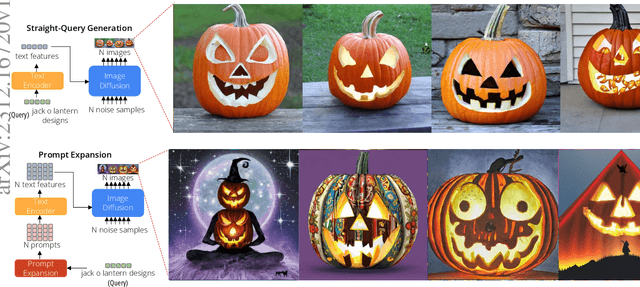
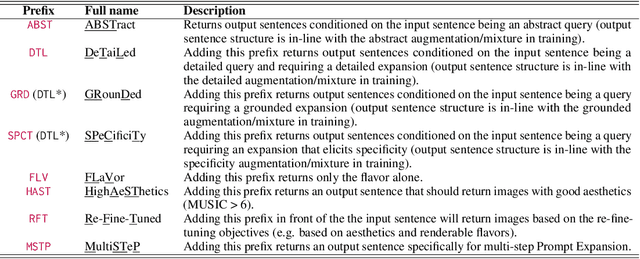
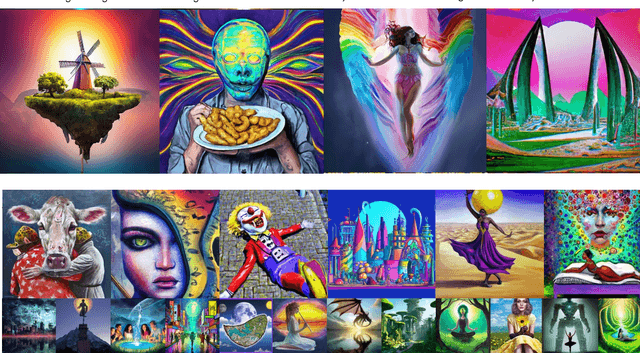
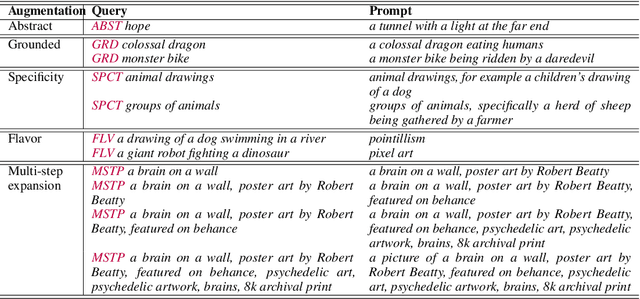
Abstract:Text-to-image generation models are powerful but difficult to use. Users craft specific prompts to get better images, though the images can be repetitive. This paper proposes a Prompt Expansion framework that helps users generate high-quality, diverse images with less effort. The Prompt Expansion model takes a text query as input and outputs a set of expanded text prompts that are optimized such that when passed to a text-to-image model, generates a wider variety of appealing images. We conduct a human evaluation study that shows that images generated through Prompt Expansion are more aesthetically pleasing and diverse than those generated by baseline methods. Overall, this paper presents a novel and effective approach to improving the text-to-image generation experience.
Gaussian Process Probes (GPP) for Uncertainty-Aware Probing
May 29, 2023



Abstract:Understanding which concepts models can and cannot represent has been fundamental to many tasks: from effective and responsible use of models to detecting out of distribution data. We introduce Gaussian process probes (GPP), a unified and simple framework for probing and measuring uncertainty about concepts represented by models. As a Bayesian extension of linear probing methods, GPP asks what kind of distribution over classifiers (of concepts) is induced by the model. This distribution can be used to measure both what the model represents and how confident the probe is about what the model represents. GPP can be applied to any pre-trained model with vector representations of inputs (e.g., activations). It does not require access to training data, gradients, or the architecture. We validate GPP on datasets containing both synthetic and real images. Our experiments show it can (1) probe a model's representations of concepts even with a very small number of examples, (2) accurately measure both epistemic uncertainty (how confident the probe is) and aleatory uncertainty (how fuzzy the concepts are to the model), and (3) detect out of distribution data using those uncertainty measures as well as classic methods do. By using Gaussian processes to expand what probing can offer, GPP provides a data-efficient, versatile and uncertainty-aware tool for understanding and evaluating the capabilities of machine learning models.
A New Path: Scaling Vision-and-Language Navigation with Synthetic Instructions and Imitation Learning
Oct 06, 2022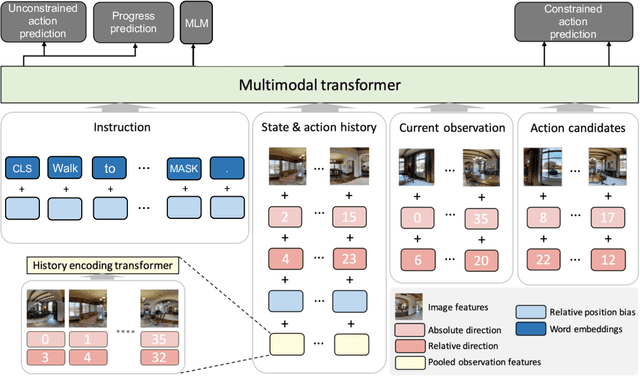

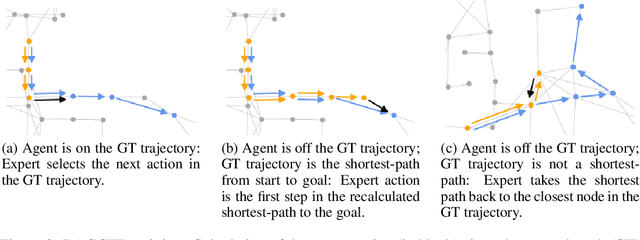
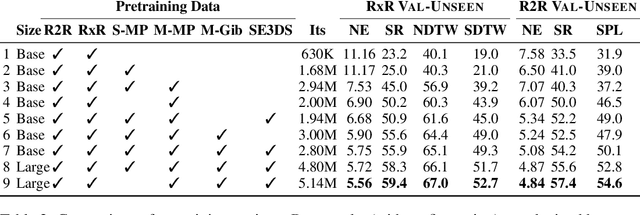
Abstract:Recent studies in Vision-and-Language Navigation (VLN) train RL agents to execute natural-language navigation instructions in photorealistic environments, as a step towards intelligent agents or robots that can follow human instructions. However, given the scarcity of human instruction data and limited diversity in the training environments, these agents still struggle with complex language grounding and spatial language understanding. Pre-training on large text and image-text datasets from the web has been extensively explored but the improvements are limited. To address the scarcity of in-domain instruction data, we investigate large-scale augmentation with synthetic instructions. We take 500+ indoor environments captured in densely-sampled 360 deg panoramas, construct navigation trajectories through these panoramas, and generate a visually-grounded instruction for each trajectory using Marky (Wang et al., 2022), a high-quality multilingual navigation instruction generator. To further increase the variability of the trajectories, we also synthesize image observations from novel viewpoints using an image-to-image GAN. The resulting dataset of 4.2M instruction-trajectory pairs is two orders of magnitude larger than existing human-annotated datasets, and contains a wider variety of environments and viewpoints. To efficiently leverage data at this scale, we train a transformer agent with imitation learning for over 700M steps of experience. On the challenging Room-across-Room dataset, our approach outperforms all existing RL agents, improving the state-of-the-art NDTW from 71.1 to 79.1 in seen environments, and from 64.6 to 66.8 in unseen test environments. Our work points to a new path to improving instruction-following agents, emphasizing large-scale imitation learning and the development of synthetic instruction generation capabilities.
Scaling Autoregressive Models for Content-Rich Text-to-Image Generation
Jun 22, 2022
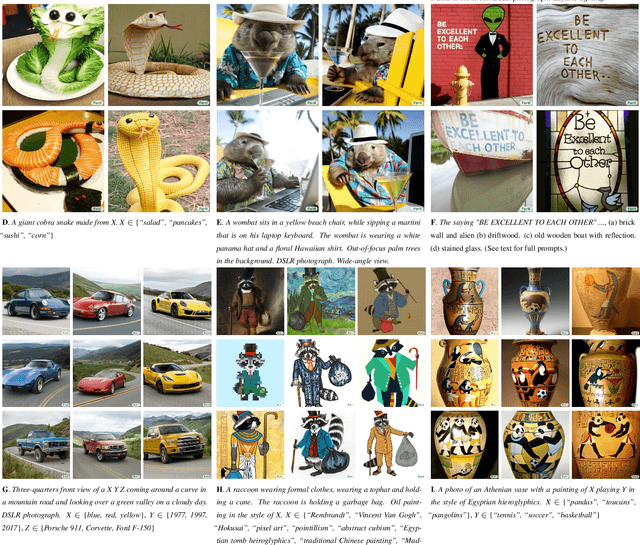

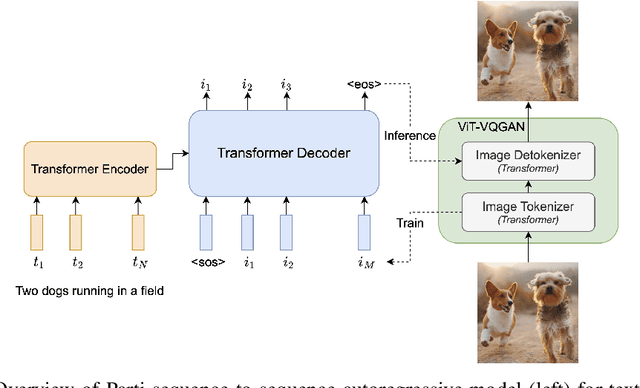
Abstract:We present the Pathways Autoregressive Text-to-Image (Parti) model, which generates high-fidelity photorealistic images and supports content-rich synthesis involving complex compositions and world knowledge. Parti treats text-to-image generation as a sequence-to-sequence modeling problem, akin to machine translation, with sequences of image tokens as the target outputs rather than text tokens in another language. This strategy can naturally tap into the rich body of prior work on large language models, which have seen continued advances in capabilities and performance through scaling data and model sizes. Our approach is simple: First, Parti uses a Transformer-based image tokenizer, ViT-VQGAN, to encode images as sequences of discrete tokens. Second, we achieve consistent quality improvements by scaling the encoder-decoder Transformer model up to 20B parameters, with a new state-of-the-art zero-shot FID score of 7.23 and finetuned FID score of 3.22 on MS-COCO. Our detailed analysis on Localized Narratives as well as PartiPrompts (P2), a new holistic benchmark of over 1600 English prompts, demonstrate the effectiveness of Parti across a wide variety of categories and difficulty aspects. We also explore and highlight limitations of our models in order to define and exemplify key areas of focus for further improvements. See https://parti.research.google/ for high-resolution images.
Vector-quantized Image Modeling with Improved VQGAN
Oct 09, 2021



Abstract:Pretraining language models with next-token prediction on massive text corpora has delivered phenomenal zero-shot, few-shot, transfer learning and multi-tasking capabilities on both generative and discriminative language tasks. Motivated by this success, we explore a Vector-quantized Image Modeling (VIM) approach that involves pretraining a Transformer to predict rasterized image tokens autoregressively. The discrete image tokens are encoded from a learned Vision-Transformer-based VQGAN (ViT-VQGAN). We first propose multiple improvements over vanilla VQGAN from architecture to codebook learning, yielding better efficiency and reconstruction fidelity. The improved ViT-VQGAN further improves vector-quantized image modeling tasks, including unconditional, class-conditioned image generation and unsupervised representation learning. When trained on ImageNet at 256x256 resolution, we achieve Inception Score (IS) of 175.1 and Fr'echet Inception Distance (FID) of 4.17, a dramatic improvement over the vanilla VQGAN, which obtains 70.6 and 17.04 for IS and FID, respectively. Based on ViT-VQGAN and unsupervised pretraining, we further evaluate the pretrained Transformer by averaging intermediate features, similar to Image GPT (iGPT). This ImageNet-pretrained VIM-L significantly beats iGPT-L on linear-probe accuracy from 60.3% to 72.2% for a similar model size. ViM-L also outperforms iGPT-XL which is trained with extra web image data and larger model size.
PanGEA: The Panoramic Graph Environment Annotation Toolkit
Mar 23, 2021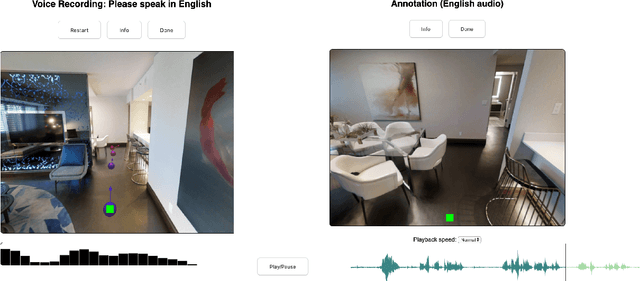

Abstract:PanGEA, the Panoramic Graph Environment Annotation toolkit, is a lightweight toolkit for collecting speech and text annotations in photo-realistic 3D environments. PanGEA immerses annotators in a web-based simulation and allows them to move around easily as they speak and/or listen. It includes database and cloud storage integration, plus utilities for automatically aligning recorded speech with manual transcriptions and the virtual pose of the annotators. Out of the box, PanGEA supports two tasks -- collecting navigation instructions and navigation instruction following -- and it could be easily adapted for annotating walking tours, finding and labeling landmarks or objects, and similar tasks. We share best practices learned from using PanGEA in a 20,000 hour annotation effort to collect the Room-Across-Room dataset. We hope that our open-source annotation toolkit and insights will both expedite future data collection efforts and spur innovation on the kinds of grounded language tasks such environments can support.
On the Evaluation of Vision-and-Language Navigation Instructions
Jan 26, 2021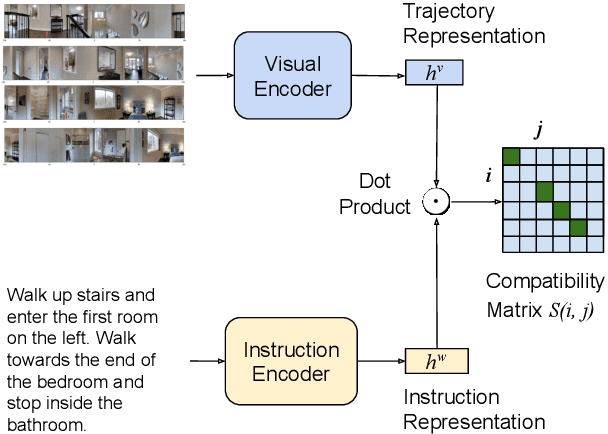

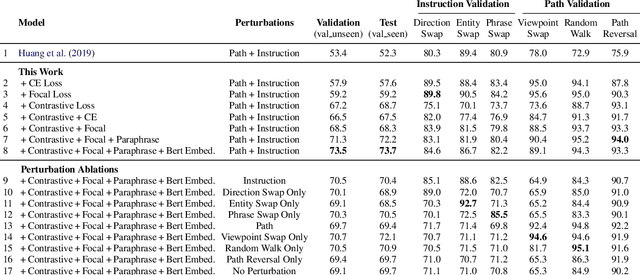

Abstract:Vision-and-Language Navigation wayfinding agents can be enhanced by exploiting automatically generated navigation instructions. However, existing instruction generators have not been comprehensively evaluated, and the automatic evaluation metrics used to develop them have not been validated. Using human wayfinders, we show that these generators perform on par with or only slightly better than a template-based generator and far worse than human instructors. Furthermore, we discover that BLEU, ROUGE, METEOR and CIDEr are ineffective for evaluating grounded navigation instructions. To improve instruction evaluation, we propose an instruction-trajectory compatibility model that operates without reference instructions. Our model shows the highest correlation with human wayfinding outcomes when scoring individual instructions. For ranking instruction generation systems, if reference instructions are available we recommend using SPICE.
 Add to Chrome
Add to Chrome Add to Firefox
Add to Firefox Add to Edge
Add to Edge